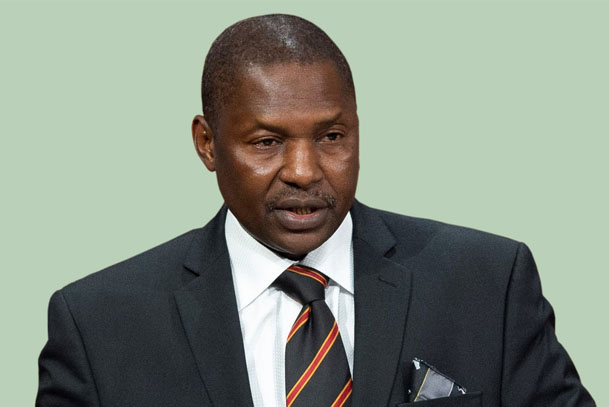Osoba: star boy at 83
IT was 11:15 a.m. The date was May 25, 2021. Olusegun Osoba, an Ẹ̀gbá, Ogun State, Grand Chief, Politician and Journalist Extraordinary, entered the compound of Okemosan, the seat of government of Ogun State. The last time he did so was eighteen years earlier, in May 2003, when he resigned as Governor of the Gateway State. Not once did he come to visit during the 16 years of governorship of the duo formed by Otunba Gbenga Daniel and Senator Ibikunle Amosun. But now the famous journalist, patron of many other journalists, was being honored by the state's outgoing governor, Prince Dapo Abiodun. A beautiful attestation of his first love – the profession of journalist – in the form of a prestigious press center – which bears his name well – was being unveiled. That the event took place in Abeokuta, the birthplace of journalism where Africa's first newspaper - Ìwé Ìròhìn Yoruba - was published in 1959 by the Reverend Henry Townsend of the Church Missionary Society, was quite telling.
The event is expected to attract many contemporary big names in the profession. All attest to Osoba's role as a torchbearer in Nigeria's media industry. He remains to this day the only Nigerian journalist to have run three national newspapers to the highest level at different times. He was first patron of the Herald newspaper. Next come Daily Sketch and Daily Times. In the field, he's been credited with mastering the scoops – a newsroom envy of editors and a term for the hottest exclusive news. For a few tense days after the first Nigerian military coup on January 15, 1966, the fate of the then Prime Minister was unknown. Many prominent political figures of the time including Sir Ahmadu Bello, Sardauna of Sokoto and enigmatic Prime Minister of the Northern Region; Chief Ladoke Akintola, Premier of the Western Region and Chief Festus Okotie-Eboh, Minister of Finance, were pronounced dead. Shot down by putschists. But where was the nation's prime minister, Sir Abubakar Tafawa Balewa? This had the nation on edge for days until young Daily Times reporter Olusegun Osoba, then 27, solved the riddle by breaking the news of Balewa's bloody transition.
Ten years later, in 1976, another bloody coup claimed the life of the then head of the military state, General Murtala Mohammed. It was led by Colonel Bukar Sukar Dimka who vanished into thin air following the collapse of the putsch. On the trail of finding the best putschist, Osoba also outpaced other reporters on the story of the fugitive putschist's arrest. "Reporting is my life," he enthused in his 341-page memoir, Battlelines. Other envious strides in the media space have earned Chief Olusegun Osoba a deserved position as a benchmark in good journalism to this day. Among the many professional bodies he heads till today include the Board of Trustees of the Nigerian Institute of Journalism, the Board of Trustees of the International Press Institute, among others. My path dutifully crossed with his in 1999 when democratic rule was reinstated in the country after a long military rule that began in 1983 when General Mohammadu Buhari sacked the Shehu Shagari administration. Chief Osoba had won election as Governor of Ogun State for the second time in 1999. The first being the election that brought him to the position on January 2, 1992. When he took the head of the government1, he dragged me among others into the executive arm of the administration.
The two Osoba administrations can only stand alongside the late Chief Bisi Onabanjo in the history of democratic governance in Ogun State. In particular, it was in the unenviable way that the two governments arrived after the military plunder. Onabanjo came after Brigadier General Harris Eghagha (Rtd) in 1979. On each of the two occasions - 1992 and 1999 - he was sworn in, Osoba succeeded a military governor. In 1992, he succeeded Navy Captain Oladeinde Joseph (retired). In 1999, he succeeded Navy Captain Kayode Olofinmoyin (retired). However, this meant starting democratic governance from scratch, in particular by establishing the legislature and the judiciary, two main victims of military rule. What he did in 1992 and repeated in 1999 after the destruction of these institutions once again by the military.
Many years of military rule in Nigeria have been marked by relentless dislocation of the socio-political structure, relentless distress in the economy and a devastating assault on the ethics of the people. Therefore, upon taking office whenever he came, Osoba took on the onerous task of totally renewing the lost character of Ogun State. Clearly, taking over after years of military rule has come with particular challenges ranging from revamping the public service system of authoritarian command-obey mentality; revamp neglected socio-infrastructural collapse and, most regrettably of all, redirect the psyche of...

IT was 11:15 a.m. The date was May 25, 2021. Olusegun Osoba, an Ẹ̀gbá, Ogun State, Grand Chief, Politician and Journalist Extraordinary, entered the compound of Okemosan, the seat of government of Ogun State. The last time he did so was eighteen years earlier, in May 2003, when he resigned as Governor of the Gateway State. Not once did he come to visit during the 16 years of governorship of the duo formed by Otunba Gbenga Daniel and Senator Ibikunle Amosun. But now the famous journalist, patron of many other journalists, was being honored by the state's outgoing governor, Prince Dapo Abiodun. A beautiful attestation of his first love – the profession of journalist – in the form of a prestigious press center – which bears his name well – was being unveiled. That the event took place in Abeokuta, the birthplace of journalism where Africa's first newspaper - Ìwé Ìròhìn Yoruba - was published in 1959 by the Reverend Henry Townsend of the Church Missionary Society, was quite telling.
The event is expected to attract many contemporary big names in the profession. All attest to Osoba's role as a torchbearer in Nigeria's media industry. He remains to this day the only Nigerian journalist to have run three national newspapers to the highest level at different times. He was first patron of the Herald newspaper. Next come Daily Sketch and Daily Times. In the field, he's been credited with mastering the scoops – a newsroom envy of editors and a term for the hottest exclusive news. For a few tense days after the first Nigerian military coup on January 15, 1966, the fate of the then Prime Minister was unknown. Many prominent political figures of the time including Sir Ahmadu Bello, Sardauna of Sokoto and enigmatic Prime Minister of the Northern Region; Chief Ladoke Akintola, Premier of the Western Region and Chief Festus Okotie-Eboh, Minister of Finance, were pronounced dead. Shot down by putschists. But where was the nation's prime minister, Sir Abubakar Tafawa Balewa? This had the nation on edge for days until young Daily Times reporter Olusegun Osoba, then 27, solved the riddle by breaking the news of Balewa's bloody transition.
Ten years later, in 1976, another bloody coup claimed the life of the then head of the military state, General Murtala Mohammed. It was led by Colonel Bukar Sukar Dimka who vanished into thin air following the collapse of the putsch. On the trail of finding the best putschist, Osoba also outpaced other reporters on the story of the fugitive putschist's arrest. "Reporting is my life," he enthused in his 341-page memoir, Battlelines. Other envious strides in the media space have earned Chief Olusegun Osoba a deserved position as a benchmark in good journalism to this day. Among the many professional bodies he heads till today include the Board of Trustees of the Nigerian Institute of Journalism, the Board of Trustees of the International Press Institute, among others. My path dutifully crossed with his in 1999 when democratic rule was reinstated in the country after a long military rule that began in 1983 when General Mohammadu Buhari sacked the Shehu Shagari administration. Chief Osoba had won election as Governor of Ogun State for the second time in 1999. The first being the election that brought him to the position on January 2, 1992. When he took the head of the government1, he dragged me among others into the executive arm of the administration.
The two Osoba administrations can only stand alongside the late Chief Bisi Onabanjo in the history of democratic governance in Ogun State. In particular, it was in the unenviable way that the two governments arrived after the military plunder. Onabanjo came after Brigadier General Harris Eghagha (Rtd) in 1979. On each of the two occasions - 1992 and 1999 - he was sworn in, Osoba succeeded a military governor. In 1992, he succeeded Navy Captain Oladeinde Joseph (retired). In 1999, he succeeded Navy Captain Kayode Olofinmoyin (retired). However, this meant starting democratic governance from scratch, in particular by establishing the legislature and the judiciary, two main victims of military rule. What he did in 1992 and repeated in 1999 after the destruction of these institutions once again by the military.
Many years of military rule in Nigeria have been marked by relentless dislocation of the socio-political structure, relentless distress in the economy and a devastating assault on the ethics of the people. Therefore, upon taking office whenever he came, Osoba took on the onerous task of totally renewing the lost character of Ogun State. Clearly, taking over after years of military rule has come with particular challenges ranging from revamping the public service system of authoritarian command-obey mentality; revamp neglected socio-infrastructural collapse and, most regrettably of all, redirect the psyche of...
What's Your Reaction?






















